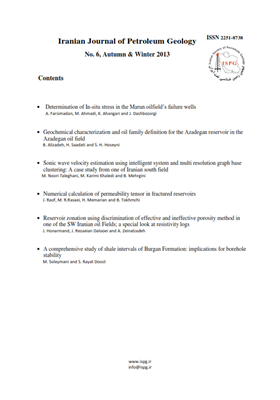Geochemical characterization and oil family definition for the Azadegan reservoir in the Azadegan oil field
Subject Areas :
1 -
Keywords: Biomarker Azadegan reservoir Kazhdumi Formation Azadegan oil field ,
Abstract :
Abstract This study aims at geochemical investigation of the hydrocarbons contained within the Azadegan sandstone reservoir by using the GC and GC-MS techniques. The Azadegan reservoir contains paraffinic and paraffinic – naphthenic oils with an API of 30. The gas chromatograms reveal that the source rocks responsible for these oils contains mainly type II kerogen deposited in a reducing environment. According to these data the studied oils have a relatively high level of thermal maturity. Ratios of C35S/C34S, C29/C30, C31R/C30 Hopane and Pr/Ph, Ph/nC18 show that the studied oil derived from carbonate source rock; which is also evident form Pr/Ph Vs. DBT/Phen diagrams. Diagrams of (20R) C29/C27 vs. Pr/Ph as well as the ratios of C21+/C21-, Pr/P, TAR are consistent with abundance of algal organic matter. Presence of Tricyclic terpanes, higher ETR ratios and diagrams of δ13C vs. Pr/P introduce a Jurassic aged source rock for the studied oils. Based on biomarker and isotopic data it could be concluded that oils within the Azadegan reservoir are mainly derived from carbonate source rocks of Mid-Upper Jurassic which are deposited in paralic/open marine environment with a predominance of algal organic matter.


